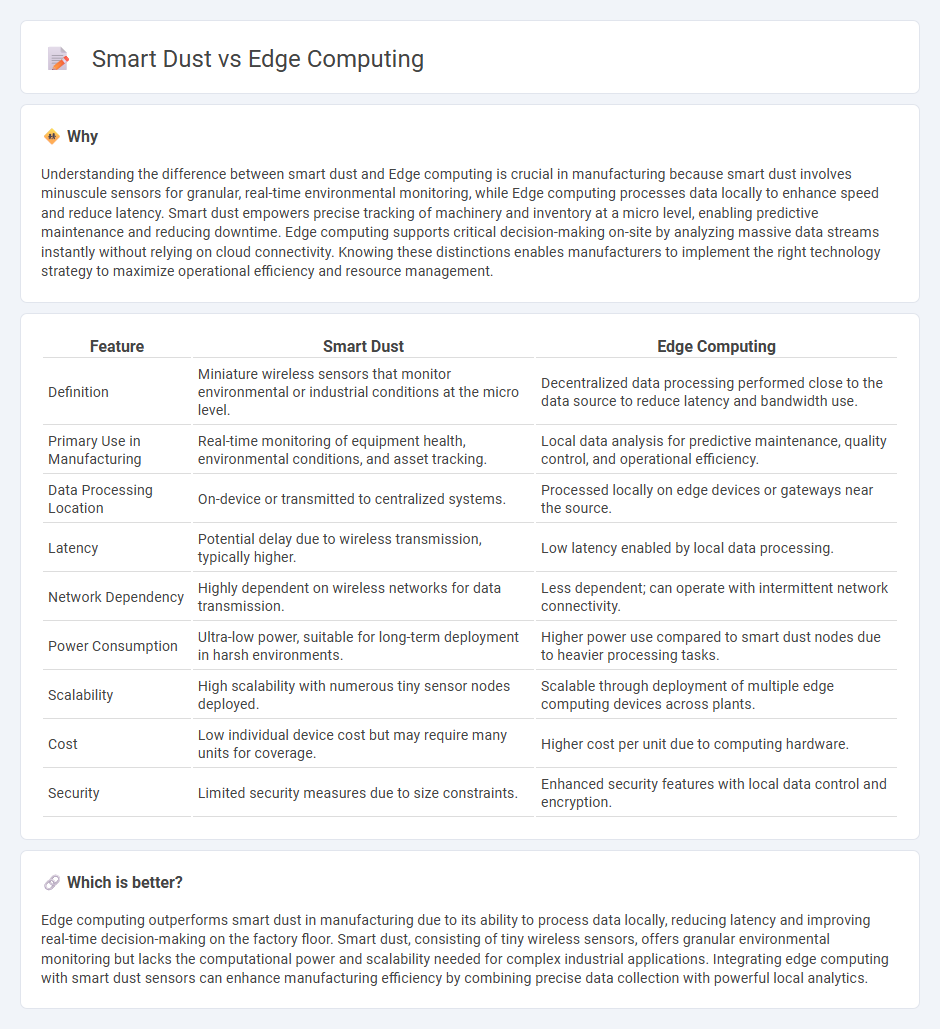
Smart dust consists of tiny, wireless microelectromechanical sensors (MEMS) capable of real-time environmental monitoring and data collection within manufacturing settings. Edge computing processes data locally near the source, reducing latency and bandwidth use while enabling faster decision-making on the factory floor. Explore the transformative impact of smart dust and edge computing on modern manufacturing operations.
Why it is important
Understanding the difference between smart dust and Edge computing is crucial in manufacturing because smart dust involves minuscule sensors for granular, real-time environmental monitoring, while Edge computing processes data locally to enhance speed and reduce latency. Smart dust empowers precise tracking of machinery and inventory at a micro level, enabling predictive maintenance and reducing downtime. Edge computing supports critical decision-making on-site by analyzing massive data streams instantly without relying on cloud connectivity. Knowing these distinctions enables manufacturers to implement the right technology strategy to maximize operational efficiency and resource management.
Comparison Table
| Feature | Smart Dust | Edge Computing |
|---|---|---|
| Definition | Miniature wireless sensors that monitor environmental or industrial conditions at the micro level. | Decentralized data processing performed close to the data source to reduce latency and bandwidth use. |
| Primary Use in Manufacturing | Real-time monitoring of equipment health, environmental conditions, and asset tracking. | Local data analysis for predictive maintenance, quality control, and operational efficiency. |
| Data Processing Location | On-device or transmitted to centralized systems. | Processed locally on edge devices or gateways near the source. |
| Latency | Potential delay due to wireless transmission, typically higher. | Low latency enabled by local data processing. |
| Network Dependency | Highly dependent on wireless networks for data transmission. | Less dependent; can operate with intermittent network connectivity. |
| Power Consumption | Ultra-low power, suitable for long-term deployment in harsh environments. | Higher power use compared to smart dust nodes due to heavier processing tasks. |
| Scalability | High scalability with numerous tiny sensor nodes deployed. | Scalable through deployment of multiple edge computing devices across plants. |
| Cost | Low individual device cost but may require many units for coverage. | Higher cost per unit due to computing hardware. |
| Security | Limited security measures due to size constraints. | Enhanced security features with local data control and encryption. |
Which is better?
Edge computing outperforms smart dust in manufacturing due to its ability to process data locally, reducing latency and improving real-time decision-making on the factory floor. Smart dust, consisting of tiny wireless sensors, offers granular environmental monitoring but lacks the computational power and scalability needed for complex industrial applications. Integrating edge computing with smart dust sensors can enhance manufacturing efficiency by combining precise data collection with powerful local analytics.
Connection
Smart dust devices generate vast amounts of real-time data from manufacturing environments, which require immediate processing to enable rapid decision-making and predictive maintenance. Edge computing processes this data locally on-site, reducing latency and bandwidth use by minimizing the need to transmit large datasets to centralized cloud servers. The integration of smart dust sensors with edge computing enhances operational efficiency, safety monitoring, and resource optimization in smart manufacturing systems.
Key Terms
Data Processing Location
Edge computing processes data near the data source, reducing latency and bandwidth usage by performing computations at or close to IoT devices and local servers. Smart dust deploys tiny, wireless microelectromechanical systems (MEMS) that collect and transmit data, often relying on centralized processing for complex analytics due to limited on-node processing power. Explore the technical distinctions and use cases to understand how data processing location impacts system efficiency and scalability.
Sensor Miniaturization
Edge computing enhances data processing by deploying computational resources closer to sensor networks, reducing latency and bandwidth usage. Smart dust represents the pinnacle of sensor miniaturization, consisting of tiny, wireless microelectromechanical sensors (MEMS) capable of environment monitoring at a microscopic scale. Explore how advancements in sensor miniaturization transform the capabilities of both edge computing and smart dust technologies.
Latency
Edge computing processes data closer to the source, significantly reducing latency compared to traditional cloud computing, which is vital for real-time applications like autonomous vehicles and industrial automation. Smart dust consists of tiny wireless microelectromechanical sensors (MEMS) that can detect and transmit data in milliseconds, offering ultra-low latency for localized, fine-grained monitoring. Explore the latest advancements in edge computing and smart dust technologies to understand their impact on latency-sensitive use cases.
Source and External Links
What Is Edge Computing? | Microsoft Azure - Edge computing is a distributed computing framework that enables IoT devices to process data and act in real time at the edge of the network, reducing latency by handling data near its source rather than sending it all to a central data center.
What Is Edge Computing? - IBM - Edge computing brings enterprise applications closer to IoT devices or local edge servers to deliver faster insights, improved response times, and more efficient bandwidth use by processing data near its creation point.
What is edge computing? | Benefits of the edge - Cloudflare - Edge computing minimizes latency and bandwidth usage by moving computing closer to data sources, allowing devices like sensors or cameras to process data locally and send only critical information to central servers.
 dowidth.com
dowidth.com